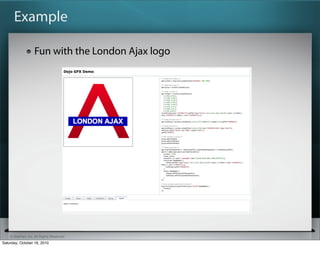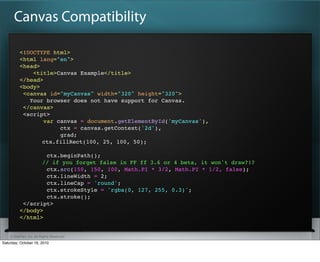Introduction to Canvas and Native Web Vector Graphics
- 1. Canvas and Web Vector Graphics Dylan Schiemann (@dylans) SitePen, Inc. HTML5 Code Camp, October, 2010 ? SitePen, Inc. All Rights Reserved Saturday, October 16, 2010
- 2. In the beginning, there was ASCII art <img /> Microsoft and VML Adobe, the W3C and SVG Firefox and Opera get native SVG Firefox, Opera and Safari get canvas All non-IE browsers get canvas and SVG IE9: 2011 ? SitePen, Inc. All Rights Reserved Saturday, October 16, 2010
- 3. 1996 Topology and Rheology of Quasi Two-Dimensional Foam http://arxiv.org/pdf/cond-mat/9904101 ? SitePen, Inc. All Rights Reserved Saturday, October 16, 2010
- 4. Raster vs. Vector Raster: Rectangular grid of pixels Pre-rendered before runtime (JPG, PNG) Rendered at runtime (Canvas) Vector: Mathematical representation of a shape Rendered at runtime (SVG) ? SitePen, Inc. All Rights Reserved Saturday, October 16, 2010
- 5. Native vs. Plug-in Open Protocols No proprietary player or studio required Use seamlessly with HTML, CSS, DOM No install needed A modular piece of the web rather than trying to replace it ? SitePen, Inc. All Rights Reserved Saturday, October 16, 2010
- 6. SVG vs. Canvas SVG Canvas Representation Pixels DOM Nodes Scalability Vector Raster Syntax/Size Verbose Terse Event Handling DOM Events Pixel Coords Browser Support IE9 beta, all majors IE9?, all majors Mobile Support Many More Animations JavaScript/SMIL Timers Accessibility Yes No Image Save No Yes (PNG or JPG) http://dev.opera.com/articles/view/svg-or-canvas-choosing-between-the-two/ ? SitePen, Inc. All Rights Reserved Saturday, October 16, 2010
- 7. 2D vs. 3D 2D SVG, Canvas, etc. 3D WebGL (FF, Chrome, Safari dev builds) replaces O3D, Canvas 3D SVG 3D Transforms ? SitePen, Inc. All Rights Reserved Saturday, October 16, 2010
- 8. CSS 3 Extensions Bringing the most important parts of SVG to HTML+CSS! Gradients Transforms (2D and 3D) Transitions Animations Masks Blurring the lines Canvas as a background image HTML elements inside SVG elements ? SitePen, Inc. All Rights Reserved Saturday, October 16, 2010
- 9. Toolkits Low-level (shapes, lines, events, etc.): DojoX GFX (SVG, VML, Canvas, Silverlight, SVGWeb) MooTools ART (SVG, VML) Processing (Canvas) Rapha?l (SVG, VML) High-level DojoX Charting, Drawing MooTools ART Widgets PlotKit and many other charting projects ? SitePen, Inc. All Rights Reserved Saturday, October 16, 2010
- 10. Toolkits Low-level (shapes, lines, events, etc.): Dojo GFX, MooTools ART, Processing, Rapha?l High-level DojoX Charting, Drawing MooTools ART Widgets PlotKit and many other charting projects ? SitePen, Inc. All Rights Reserved Saturday, October 16, 2010
- 11. Let's Draw Something ? SitePen, Inc. All Rights Reserved Saturday, October 16, 2010
- 12. Canvas Code - Basic Structure <!DOCTYPE html> <html lang="en"> <head> <title>Canvas Example</title> </head> <body> <!-- canvas element; container --> <canvas id="myCanvas" width="320" height="320"> Your browser does not have support for Canvas. </canvas> </body> </html> ? SitePen, Inc. All Rights Reserved Saturday, October 16, 2010
- 13. Canvas Example: London Ajax Logo <script> // Set up a few variables, including our canvas and context var canvas = document.getElementById('canvas'), ctx = canvas.getContext('2d'), grad; // Build the path for the V ctx.beginPath(); ctx.moveTo(7, 105); ctx.lineTo(25, 105); ctx.lineTo(60, 31); ctx.lineTo(96, 105); ctx.lineTo(114, 105); ctx.lineTo(69, 11); ctx.lineTo(52, 11); ctx.closePath(); // Set up the stroke ctx.strokeStyle = '#a70017'; ctx.stroke(); // Set up the gradient grad = ctx.createLinearGradient(0, 0, 0, 105); grad.addColorStop(0, '#f3001f'); grad.addColorStop(1, '#a40016'); ? SitePen, Inc. All Rights Reserved Saturday, October 16, 2010
- 14. Canvas Example: London Ajax Logo (cont) // ... code continued from previous slide ... // Apply the gradient to the V ctx.fillStyle = grad; ctx.fill(); // Create the blue box ctx.fillStyle = '#0000ae'; ctx.fillRect(8, 68, 103, 16); // Create the text ctx.font = 'bold 9pt Arial'; ctx.fillStyle = '#ffffff'; ctx.fillText('LONDON AJAX', 16, 80); ctx.strokeStyle = '#ffffff'; ctx.strokeText('LONDON AJAX', 16, 80); </script> ? SitePen, Inc. All Rights Reserved Saturday, October 16, 2010
- 15. SVG Code - Basic Structure <?xml version="1.0" standalone="no"?> <!DOCTYPE svg PUBLIC "-//W3C//DTD SVG 1.1//EN" "http://www.w3.org/Graphics/SVG/1.1/ DTD/svg11.dtd"> <!-- containing node --> <svg width=?"480" height=?"480">? <!-- defs: contains "referenced" elements --> <defs>? </defs>? <!-- add all shapes here --> </svg> ? SitePen, Inc. All Rights Reserved Saturday, October 16, 2010 I think of Ī░defsĪ▒ as almost an array of vars, indexed by an ID attribute
- 16. SVG Example: London Ajax Logo <?xml version="1.0" standalone="no"?> <!DOCTYPE svg PUBLIC "-//W3C//DTD SVG 1.1//EN" "http://www.w3.org/Graphics/SVG/1.1/ DTD/svg11.dtd"> <!-- container --> <svg width="480" height="480" xmlns="http://www.w3.org/2000/svg" version="1.1">? <!-- definitions --> <defs>? <!-- linear gradient for the "A" --> <!-- referenced as "Gradient1" --> <linearGradient id="Gradient1" gradientUnits="userSpaceOnUse" x1="0.00000000" y1="0.00000000" x2="0.00000000" y2="420.00000000">? <stop offset="0.00000000" stop-color="rgb(243, 0, 31)" stop-opacity="1">?</ stop>? <stop offset="1.00000000" stop-color="rgb(164, 0, 22)" stop-opacity="1">?</ stop>? </linearGradient>? </defs>? <!-- shapes on next slide --> ? SitePen, Inc. All Rights Reserved Saturday, October 16, 2010
- 17. SVG Example: London Ajax Logo (cont.) <!-- polyline to create the upside down "V" shape --> <!-- uses gradation fill --> <polyline fill="url(/slideshow/html5-codecampcanvasvectors/5460205/)" style="fill:url(/slideshow/html5-codecampcanvasvectors/5460205/);" stroke="rgb(167, 0, 23)" stroke-opacity="1" stroke-width="1" stroke-linecap="butt" stroke- linejoin="miter" stroke-miterlimit="4" points="28 420 100 420 240 124 384 420 456 420 276 44 208 44 28 420" stroke-dasharray="none" fill-rule="evenodd" /> <!-- blue rect shape to complete the "A" --> <rect fill="rgb(0, 0, 174)" fill-opacity="1" stroke="none" stroke-opacity="0" stroke-width="1" stroke-linecap="butt" stroke-linejoin="miter" stroke- miterlimit="4" x="32" y="272" width="412" height="64" fill-rule="evenodd" />? <!-- text for "LONDON AJAX" --> <text fill="rgb(255, 255, 255)" fill-opacity="1" stroke="none" stroke- opacity="0" stroke-width="1" stroke-linecap="butt" stroke-linejoin="miter" stroke- miterlimit="4" x="64" y="320" text-anchor="start" text-decoration="none" rotate="0" kerning="auto" text-rendering="optimizeLegibility" font-style="normal" font- variant="normal" font-weight="bold" font-size="36pt" font-family="Arial" fill- rule="evenodd">?LONDON AJAX?</text>? </svg> ? SitePen, Inc. All Rights Reserved Saturday, October 16, 2010 https://user.sitepen.com/~dwalsh/ajax-london.svg
- 18. Two Ways to Include SVG <object> <iframe> ? SitePen, Inc. All Rights Reserved Saturday, October 16, 2010
- 19. GFX Example: London Ajax Logo <!-- node which will contain the drawing --> <script> // Require gfx dojo.require('dojox.gfx'); dojo.require('dojox.gfx.gradient'); // When the resources have loaded.... dojo.ready(function() { // Grab the DIV that will contain the drawing var refNode = dojo.byId('someNode'); // Create the GFX "surface" var surface = new dojox.gfx.createSurface(refNode,120,120); ? SitePen, Inc. All Rights Reserved Saturday, October 16, 2010
- 20. GFX Example: London Ajax Logo (cont) // Create an upside-down "V" surface.createPolyline([ { x:7, y:105 }, { x:25, y:105 }, { x:60, y:31 }, { x:96, y:105 }, { x:114, y:105 }, { x:69, y:11 }, { x:52, y:11 }, { x:7, y:105 } ]). setStroke({color:'#a70017'}). setFill({ type:'linear', x1:0, y1:0, x2:0, y2:105, colors: [{ offset:0, color:'#f3001f'},{ offset:1, color:'#a40016'}] }); // Create the blue box surface.createRect({ x:8, y:68, width:103, height:16 }). setFill('#0000ae'); // Create the text surface.createText({ x:16, y:80, text:'LONDON AJAX', align:'start'}). setFont({ family:'Arial', size:'9pt', weight:'bold' }). setFill('#ffffff'); }); </script> ? SitePen, Inc. All Rights Reserved Saturday, October 16, 2010
- 21. Example Fun with the London Ajax logo ? SitePen, Inc. All Rights Reserved Saturday, October 16, 2010
- 22. Canvas Compatibility <!DOCTYPE html> <html lang="en"> <head> <title>Canvas Example</title> </head> <body> <canvas id="myCanvas" width="320" height="320"> Your browser does not have support for Canvas. </canvas> <script> var canvas = document.getElementById('myCanvas'), ctx = canvas.getContext('2d'), grad; " " ctx.fillRect(100, 25, 100, 50); ctx.beginPath(); " " // if you forget false in FF ff 3.6 or 4 beta, it won't draw?!? ctx.arc(150, 150, 100, Math.PI * 3/2, Math.PI * 1/2, false); ctx.lineWidth = 2; ctx.lineCap = 'round'; ctx.strokeStyle = 'rgba(0, 127, 255, 0.3)'; ctx.stroke(); </script> </body> </html> ? SitePen, Inc. All Rights Reserved Saturday, October 16, 2010
- 23. ? SitePen, Inc. All Rights Reserved Saturday, October 16, 2010
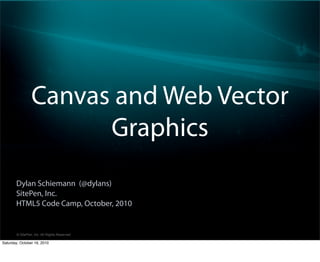
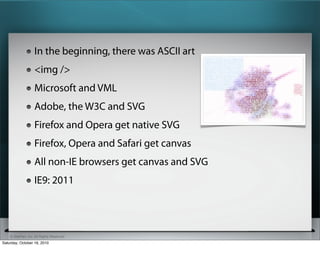
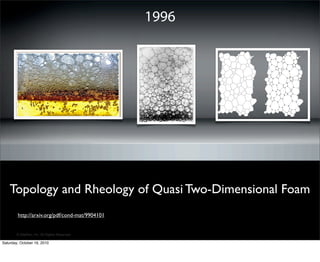
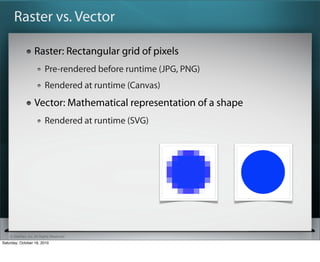
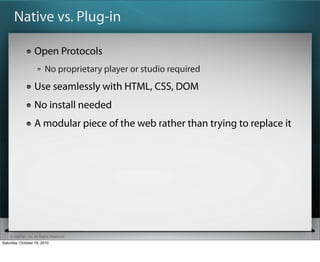

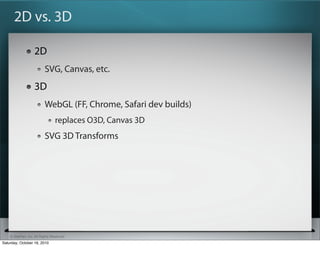
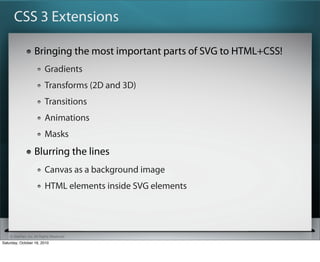
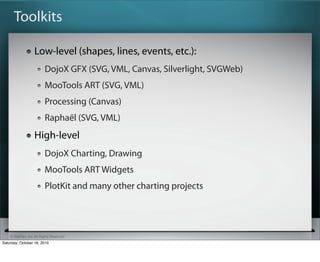
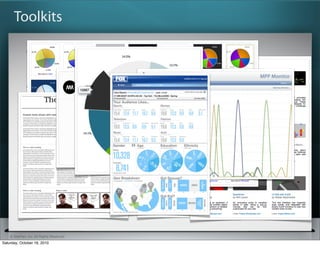
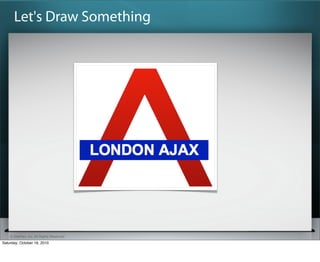
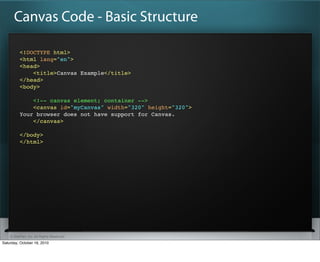
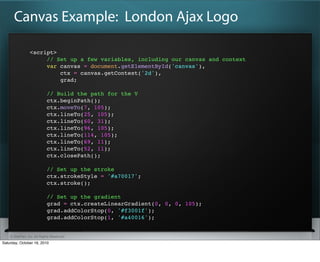
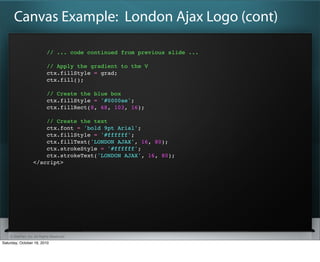
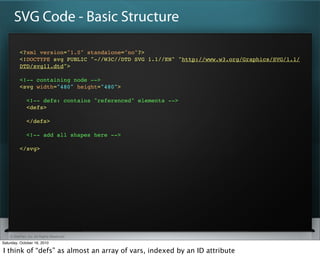
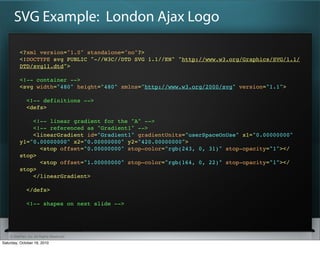
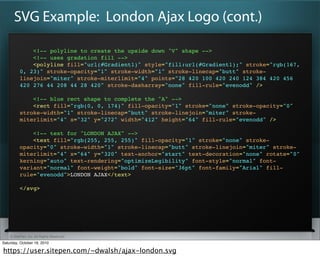
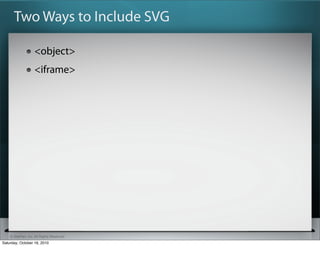
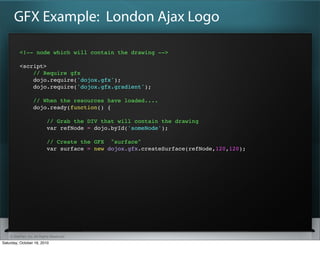
![GFX Example: London Ajax Logo (cont)
// Create an upside-down "V"
surface.createPolyline([
{ x:7, y:105 },
{ x:25, y:105 },
{ x:60, y:31 },
{ x:96, y:105 },
{ x:114, y:105 },
{ x:69, y:11 },
{ x:52, y:11 },
{ x:7, y:105 }
]).
setStroke({color:'#a70017'}).
setFill({ type:'linear', x1:0, y1:0, x2:0, y2:105, colors: [{ offset:0,
color:'#f3001f'},{ offset:1, color:'#a40016'}] });
// Create the blue box
surface.createRect({ x:8, y:68, width:103, height:16 }).
setFill('#0000ae');
// Create the text
surface.createText({ x:16, y:80, text:'LONDON AJAX', align:'start'}).
setFont({ family:'Arial', size:'9pt', weight:'bold' }).
setFill('#ffffff');
});
</script>
? SitePen, Inc. All Rights Reserved
Saturday, October 16, 2010](https://image.slidesharecdn.com/html5codecampcanvasvectors-101016090757-phpapp02/85/Introduction-to-Canvas-and-Native-Web-Vector-Graphics-20-320.jpg)
